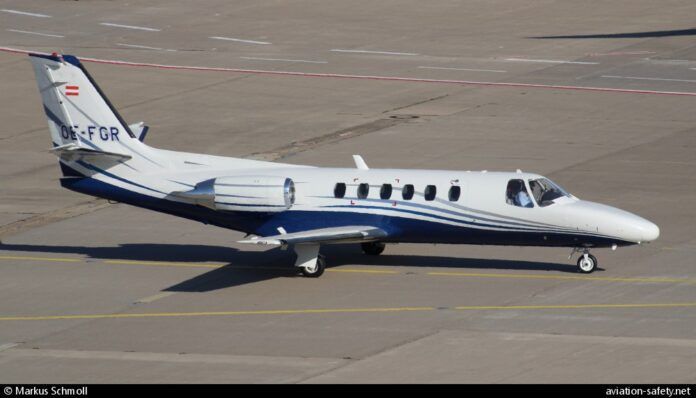Searchers have found debris and human remains at the assumed crash site of a Cessna Citation II SP off the coast of Latvia. Lt. Cmdr. Peteris Subbota, head of the Latvian military’s Marine Search and Rescue Coordination Centre, told The Associated Press, “[We found] remains of human bodies we believe to be associated with the crash.” Since the disappearance of the twinjet on Monday, vessels of the Latvian coast guard as well as underwater robots have been searching the Baltic Sea about 25 miles northwest of the Latvian port city of Ventspils. A prominent German businessman and his family members are believed to be among the four assumed dead in the crash.
The Austrian-registered (OE-FGR) business jet departed from Jerez-LaParra Airport in Spain at 12:56 UTC on Monday, headed for Cologne, Germany, about a 2-hour, 30-minute flight. Upon entering German airspace at 36,000 feet near Cologne and apparently beginning to maneuver for landing, the pilot of the single-pilot-capable Citation stopped responding to air traffic control. The aircraft maintained its altitude and continued on a northeasterly heading until it apparently ran out of fuel and descended into the Baltic Sea at a final rate of 8,000 feet per minute.
German and Danish jet fighters intercepted the Citation as it passed through their airspace. Johan Wahlstrom of the Swedish Maritime Administration said the military pilots were unable to make contact. “They could not see anyone in the cockpit.”




































If I may, because I read it in mainstream news, the story didn’t unfold exactly as you say: Actually, Spanish ATC lost radio contact with the flight soon after it entered cruise, and notified French ATC. The French scrambled a Rafale (which is standard procedure for unresponsive flights), which made visual contact. The fighter’s pilot indicated that he was seeing “no one in the cockpit”, which probably meant that the pilot had collapsed. The flight was followed along its filed (and probably programmed) flight plan, briefly crossed the Belgian and Dutch borders, then a German Eurofighter took over when it entered German airspace and followed it until it overshot Cologne and crashed into the Baltic, probably from fuel exhaustion. The Spaniards said that in his last communication, the pilot had mentioned having pressurization problems.
Like the Helios B737 Cyprus-Greece,which was entirely caused by a failure of the crew to use the Boeing checklist which would have ensured pressurisation was set for flight, PACKS ON FLIGHT. (flight ground switch goes from ground to flight) followed by a complete failure to check cabin alt & rate of climb passing FL100. I was a 737 type rating instructor and examiner at he time, when chatting to a former BA chum who had just left Helios, his firm advice to me “Don’t buy a ticket” So I didn’t. The single crew jet operation is something I experienced in single seat fighters, never in a commercial operation, so I’m unable to offer an opinion on its safety or security. Did have a total sudden pressurisation failure in a BA 737-200 but that was a long time ago.
Unfortunate since the aircraft is designed to allow pilots to survive such an event. I’ve flown with a lot of single-pilot owner/operators and many of them practice emergency oxygen only once a year for their recurrent training and I never saw any of them actually test oxygen delivery, just the mechanics of donning the mask and flicking the lever. Sloppy maintenance and checklist use could also have set the pilot up with a system that didn’t work as designed. I look at these the same as CFIT though – they should never happen, and yet they do. People forget how fragile they are and get careless…
I am wondering if the lack of actual Emer mask training with sim providers in pressurized airplanes due to Covid the last few years is creating a situation where more of these accidents are starting to occur. I like to check not only if there is O2 flow in Emer mask but also to see the quick donning straps inflate properly. I have seen where the mask has O2 flow but the inflatable straps on a quick donning type won’t properly inflate.
One would think an aural/visual cabin altitude warning would be sufficient to alert the crew. The cabin altitude gauge also needs watching. If this was a Rapid Decompression, then all Hell breaks loose with fog/debris/ears popping/warnings and screams (If applicable.) In an Air Force Altitude Chamber, I was trained for those procedures, but my ear block during the Hypoxia Descent Phase nixed my attendance in the RD segment. I did see what happens during such events.